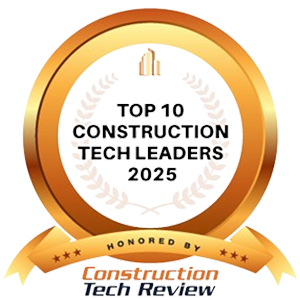THANK YOU FOR SUBSCRIBING

Redefining Project Management with Connected Construction Tech
Shanthi Rajan, CEO and Founder, Linarc

 Shanthi Rajan, CEO and Founder, Linarc
Shanthi Rajan, CEO and Founder, LinarcShanthi Rajan is a seasoned entrepreneur and product leader with deep expertise in building enterprise applications. She's worn many hats, from investing in a conversational AI customer engagement solution to leading a company acquired by IBM. Currently, she’s the founder and CEO of Linarc, a cloud-based construction management software that empowers organizations to foster seamless team collaboration.
In an interview with Construction Tech Review, Rajan shared insights on her career trajectory, her hands-on approach to leadership and the significance of bringing all stakeholders into a shared digital workspace to facilitate seamless construction project management.
Building on a Robust Technical Foundation
Before founding Linarc, I built two enterprise technology products—one in immersive learning and another in omnichannel customer relationship management. These early ventures instilled in me the core principles of platform thinking, user-centric design and solving real-world problems. These principles continue to guide my work today.
Each product was the result of identifying a specific pain point and then taking a thoughtful, iterative approach to building a scalable solution. Most importantly, I learned that successful platforms are not just about feature sets but about aligning technology with operational rigor and workflows that reflect how businesses truly operate.
This mindset laid the groundwork for building Linarc, where I saw an opportunity to bring the power of connected platforms into the construction industry.
Leading with Conviction and Flexibility
Leadership in a startup environment demands staying power. It requires the discipline to dig deep into prevalent issues, the patience to validate assumptions with real users and the resilience to evolve the product based on continuous learning.
“As construction digitization accelerates, AI and field technology stand out as the most transformative forces on the horizon. AI is adeptly positioned to simplify some of the industry’s most complex problems, whether optimizing schedules or contextualizing site data for faster decision-making”
In the construction industry, my assumptions were challenged almost immediately. What I thought I understood quickly gave way to deeper insights as I engaged more customers. Each project and company had its nuanced processes. This feedback loop shaped Linarc into a flexible and highly adaptable platform.
A hands-on approach to leadership is crucial to understanding what motivates each team member and creating space for them to grow. When people feel aligned with a shared purpose, they’re more willing to invest their time and creativity into solving complex challenges.
Addressing the Gaps in Construction Tech
Most construction technology tools today fall into two categories: point solutions that solve one functional area, like scheduling or document management, or tools designed for specific stakeholder groups, such as general contractors or subcontractors.
From the outset, I took a different approach. I looked at construction not as a series of disconnected tasks but as a single, unified project journey. From this perspective, the artificial boundaries between roles and tools become less relevant. At the end of the day, taking a design from plans and specifications to a completed building that will serve its purpose for decades is what matters most.
With this perspective, we built Linarc as a project-centric platform, bringing all stakeholders into a shared digital workspace. Each participant can create and manage data relevant to their scope while the system aggregates this information to provide full-lifecycle visibility, allowing teams to make decisions based on shared, real-time data.
Innovating Responsibly with Emerging Technologies
As construction digitization accelerates, AI and field technology stand out as the most transformative forces on the horizon. AI is adeptly positioned to simplify some of the industry’s most complex problems, whether optimizing schedules or contextualizing site data for faster decision-making.
At Linarc, we focus on applying AI to reduce the cognitive load on project managers and field teams. When AI is integrated in ways that preserve usability and align with existing workflows, adoption becomes more intuitive and more impactful. In parallel, the rise of connected equipment, geo-aware mobile apps and real-time sensor data is rapidly changing how teams operate in the field. The opportunity lies in integrating these technologies into a collaborative decision-making framework. This way, everyone—onsite or offsite—can access the same actionable insights.
Balancing Vision with Customer-Centricity
Balancing innovation with customer needs is an ongoing responsibility. Every product decision we make is grounded in understanding where the industry is headed and what the customer is ready for today. Our approach is to introduce change in ways that feel natural and drive clear value, helping teams evolve their workflows without abandoning the tools and practices they rely on.
We have embedded a culture of customer-centricity into Linarc from day one. Whether it’s engineers or product leads, everyone is encouraged to think from the user’s perspective and constantly ask themselves: Will this design enhance usability? Will it simplify the customer’s day-today work? This mindset ensures that our innovations are grounded in practicality and purpose driven.
A Word of Advice for Aspiring Entrepreneurs
Building a startup is a long-term journey, not a point in time. It requires deep conviction in your vision and a clear understanding of your motivations. Founders must be prepared to put in the time and effort to realize their goals. Before taking the plunge, validating your vision through meaningful conversations with industry stakeholders is essential. This helps ensure there’s a real market need for your product and that your solution resonates with potential users.
As you begin building, stay open to learning and adapting. As your initial assumptions evolve, surround yourself with a flexible, responsive team that can incorporate early feedback into your design and development process. This is the ultimate key to creating a product that truly fits the market.
Instilling a customer-centric culture from day one is equally vital. Teams must be grounded in the needs and behaviors of end-users. It’s not just about what’s technically possible but about what adds value and usability for customers. This mindset should inform every design and development decision.
Read Also
Development of the Logistics Warehousing Market in Brazil
Driving Innovation and Preserving Tradition
Operational Leadership VS Field Leadership in the Utility Construction Business
People-First Innovation: Developing Virtual Design and Construction (VDC) Training Programs to Empower Field Team Members
Sustainable Projects: Aligning Business and Purpose in Latin America
Engage Smarter: Why Constraints Matter More Than Hazards

 Copyright © 2025 All Rights Reserved | by:
Copyright © 2025 All Rights Reserved | by: Construction Tech Review
| Subscribe | About us | Sitemap| Editorial Policy| Feedback Policy















